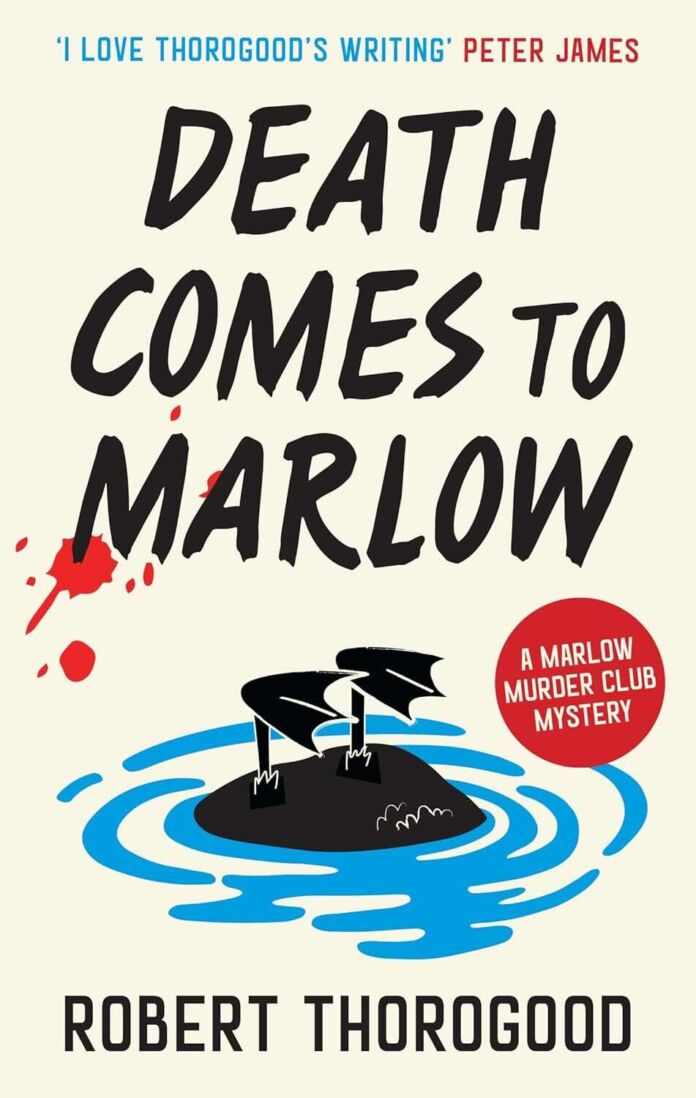Robert Thorogood’s second installment in The Marlow Murder Club series, Death Comes to Marlow, brings back our beloved trio of amateur sleuths—the eccentric septuagenarian Judith Potts, dog-walker turned radio personality Suzie Harris, and the vicar’s wife Becks Starling. Following their successful debut in solving murders in the first book, The Marlow Murder Club, they now face an even more perplexing case that challenges not just their detective skills but also their friendship.
A Locked-Room Mystery with Modern Sensibilities
The story begins with Judith’s characteristic skinny-dipping adventure in the Thames, setting up both her unconventional personality and the picturesque setting of Marlow. When Sir Peter Bailey, a local grandee, is found dead in his study the day before his wedding to nurse Jenny Page, what initially appears to be a tragic accident evolves into something far more sinister. The twist? The study was locked from the inside, with the only key found in the deceased’s pocket.
Thorogood masterfully crafts a classic locked-room mystery while infusing it with contemporary elements. The author’s experience as the creator of BBC’s Death in Paradise shines through in his ability to construct intricate puzzles that keep readers guessing until the final revelation.
Character Development and Dynamics
What sets this book apart from typical cozy mysteries is its deep character development:
- Judith Potts remains delightfully eccentric, but we see more vulnerability beneath her confident exterior
- Suzie Harris struggles with balancing her newfound local celebrity status as a radio host with her dog-walking business
- Becks Starling reveals unexpected depths as she grapples with her identity beyond being the perfect vicar’s wife
The interpersonal dynamics between these three distinctly different women form the emotional core of the story, making their investigation more than just a puzzle-solving exercise.
Strengths and Notable Elements
Masterful Plot Construction
Thorogood excels at laying out clues and red herrings with precision. The solution to the locked-room mystery is both ingenious and satisfying, requiring careful attention to seemingly insignificant details scattered throughout the narrative.
Rich Setting
The author’s portrayal of Marlow, with its riverside mansions and small-town politics, creates a vivid backdrop that feels both cozy and authentic. The contrast between the town’s peaceful facade and the dark undercurrents of murder adds depth to the storytelling.
Humor and Heart
Despite dealing with murder, the book maintains a light touch through witty dialogue and amusing situations, particularly in scenes involving Judith’s unconventional methods of investigation.
Areas for Improvement
Pacing Issues
The middle section of the book occasionally drags, with some investigative sequences feeling repetitive. A tighter edit could have maintained the momentum better.
Complex Plot Elements
While the intricate plot is generally a strength, some readers might find the number of suspects and motives overwhelming. The resolution, though clever, requires a significant exposition dump to explain all the moving parts.
Secondary Character Development
Some supporting characters could have been more fully developed, particularly the police officers who seem somewhat two-dimensional compared to our main trio.
Series Context
Death Comes to Marlow builds effectively on the foundation laid in The Marlow Murder Club, the first book where we met our unlikely detective trio. The series continues with The Queen of Poisons and Murder on the Marlow Belle, maintaining the high standards of mystery writing while exploring new dynamics between the characters.
Writing Style and Technical Elements
Thorogood’s prose is clear and engaging, with a particular talent for:
- Sharp dialogue that reveals character
- Vivid scene-setting without excessive description
- Clever integration of clues into seemingly casual observations
- Balanced pacing between investigation and character moments
Comparative Analysis
Fans of traditional British mysteries will find familiar elements reminiscent of Agatha Christie’s work, particularly her Marple series. However, Thorogood brings a modern sensibility to the genre, addressing contemporary themes while maintaining the charm of classic detective fiction.
Final Verdict
While not flawless, it successfully combines the best elements of traditional mystery writing with contemporary storytelling sensibilities. The book will particularly appeal to readers who enjoy:
- Complex puzzle mysteries
- Strong female protagonists
- British small-town settings
- Character-driven narratives
- A blend of humor and suspense
Recommendation
This book is highly recommended for fans of traditional British mysteries who appreciate modern twists on classic formulas. While it can be read as a standalone, starting with the first book in the series will provide a richer reading experience. The clever plotting, engaging characters, and satisfying resolution make it a worthy addition to any mystery lover’s library.
The Marlow Murder Club series has established itself as a significant contribution to contemporary British mystery fiction, and Death Comes to Marlow cements its position as a series worth following.





